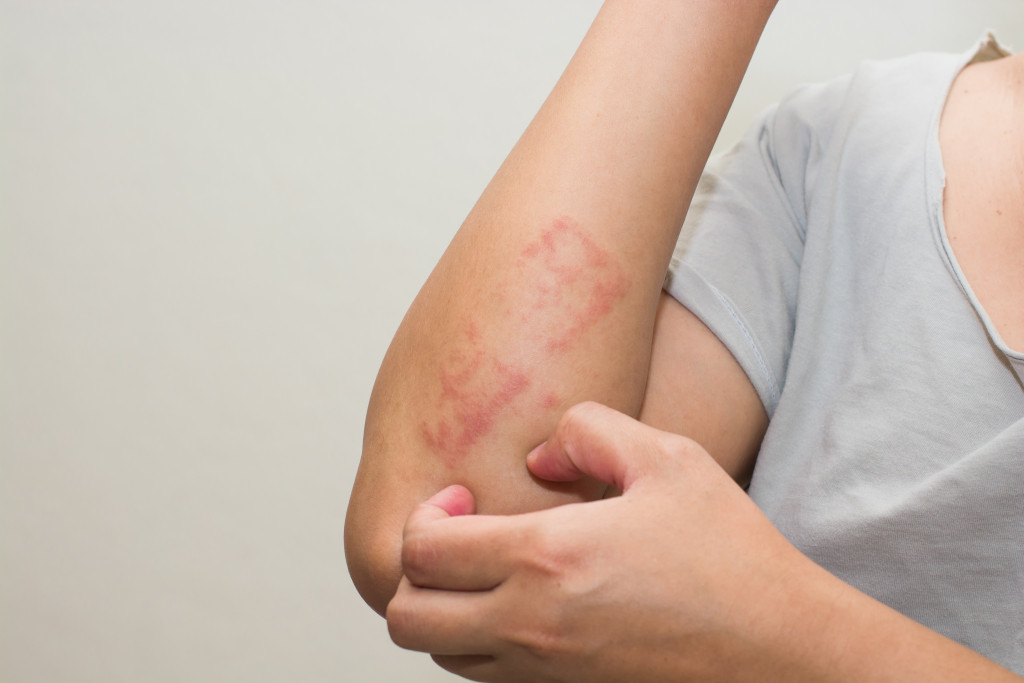- Dyshidrotic eczema causes small blisters on hands and feet due to an abnormal immune response.
- Risk factors include stress, allergies, moisture, weather changes, and immune system issues.
- Treatments include face treatments like Botox, creams, ointments, and light therapy.
- Phototherapy can reduce pain, blisters, and lesions; products can reduce inflammation and itching.
- If you think you may have dyshidrotic eczema, contact your doctor for a diagnosis and treatment plan.
Eczema is a common skin condition that affects millions of people worldwide. It is a chronic and inflammatory skin disorder that causes redness, itching, and sometimes even blisters. One type of eczema that is less commonly known is dyshidrotic eczema. It affects the hands and feet, and it can be challenging to treat. Here’s what dyshidrotic eczema is, its causes, symptoms, and treatment options.
What Is Dyshidrotic Eczema?
Dyshidrotic eczema causes small, itchy blisters on the soles of the feet, palms of the hands, and sides of the toes and fingers. The blisters are often painful and can cause extensive itching, redness, and discomfort. The condition can last for weeks to months and can recur frequently. Its exact cause is unknown, but it is thought to be due to an allergic or abnormal immune system response.
Symptoms of Dyshidrotic Eczema
Dyshidrotic eczema typically affects the hands and feet but can also occur in other body parts. Its primary symptom is the appearance of small, fluid-filled blisters that can cause intense itching and pain. The blisters may merge, and the affected skin can become scaly or cracked. In severe cases, the blisters may become infected or lead to a secondary bacterial infection.
Risk Factors
Different people can experience this kind of skin disorder. However, certain risk factors can make you vulnerable to it. Here are some of those risk factors:

Stress
Stress has been identified as a trigger for many types of eczema, including dyshidrotic. When you’re under stress, your body produces certain hormones that can negatively impact your skin’s immune system. This can lead to an increased risk of developing dyshidrotic eczema and worsening existing symptoms. You might try relaxation techniques like yoga or meditation to minimize stress in your daily life.
Allergies
Allergic reactions are also known to be linked with the development of dyshidrotic eczema. In many cases, the blisters associated with this condition are triggered by contact with certain irritants or allergens. For instance, some people may experience an outbreak after touching nickel, latex, or certain chemicals. It’s essential to identify and minimize your exposure to environmental allergens.
Moisture
Moisture can also play a significant role in the development of dyshidrotic eczema. This type of eczema often occurs in people with sweaty or damp hands and feet, increasing the risk of developing blisters. It is crucial to keep your hands and feet dry as much as possible to prevent this from happening. If you sweat excessively, you might use an antiperspirant to keep your hands and feet dry.
Weather Changes
Although the reasons for this are not fully understood, changes in weather conditions have also been linked to dyshidrotic eczema. Some people may experience more frequent outbreaks during certain seasons, particularly in hot weather. To minimize the impact of weather changes, you may need to adjust your skincare routine to adapt to the changing conditions.
Immune system issues
Dyshidrotic eczema is also linked to specific immune system problems, such as an overactive immune response. When your immune system overreacts, it can cause inflammation and other symptoms that can lead to the development of various skin conditions. A compromised immune system due to other underlying health conditions can also increase the risk of this condition.
Treatments
There are various treatments available for dyshidrotic eczema. Depending on the severity of your symptoms, your doctor may recommend one or more of the following:

Face Treatment
Certain face treatments can treat dyshidrotic eczema. A robust botox treatment is one of the most effective forms of treatment. This is because Botox can effectively reduce inflammation and other symptoms. It can also stop the body from producing irritants that may trigger an outbreak of blisters.
Creams and Ointments
Various creams and ointments are available to help manage dyshidrotic eczema. Your doctor will recommend a product, such as anti-inflammatory creams or steroid ointments, depending on your specific needs. These products can help reduce inflammation and symptoms of itching and redness.
Light Therapy
Light therapy is another treatment option for dyshidrotic eczema. Phototherapy, which involves exposing the skin to specific wavelengths of light, can reduce pain and discomfort associated with the condition. It can also reduce blisters’ appearance and help heal any existing lesions.
Dyshidrotic eczema is a common but often misunderstood skin condition. Knowing the causes, symptoms, and treatment options can help you get relief from this condition and manage flare-ups more effectively in the future. If you think you may have dyshidrotic eczema, contact your doctor for a diagnosis and treatment plan.


